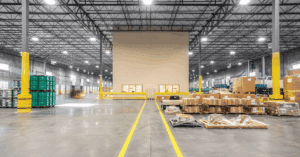United States retail imports are facing a year-long low, coming into the early spring months. Top US retail ports are estimating 1.59 million TEU (twenty foot equivalent unit) will ship through their facilities this March. This volume is up 3.2% from last March, but still the lowest figure seen since April 2018. The National Retail Federation has an explanation as to why numbers are down – partly due to less demand during holiday offseason, but mostly due to threatening tariffs. These tariffs cause businesses and consumers to debate which is more important: free trade or protectionist policies.
Free Trade
Free trade is the open trade between businesses or nations with the absence of trade barriers such as tariffs. Tariffs are added fees for imported goods. These fees are applied directly to each item brought in from foreign nations, and whose cost are passed directly on to the consumer. Each product is different in the way and amount it is charged. For example, tennis shoes are given a 5 percent duty when made outside of the US. That cost is added on and transferred to the consumer. Proponents for lower cost goods, prefer free trade agreements between nations. Companies are free to trade and the market will determine the best price. Then, the savings are transferred to the consumer instead. Other benefits include:
• Higher quality goods – Allowing more competition in the marketplace demands that the best products survive and the worst are weeded out.
• More growth – According to the CIA world factbook, the majority of top imported items are inputs for other products (e.g. steel, aluminum, oil, etc.). Making these products cheaper allows US manufacturers to produce cheaper, higher quality products as well. This allows US companies the chance to grow organically.
• Improved efficiency and innovation – By allowing the market to work on its own, more workers and resources will go where they are needed most. Protectionist philosophy creates a standard that there must be so many of each type of industry with a specified allotment of workers, etc. But free markets force workers to adapt and change. During the Industrial Revolution, more workers transitioned from agriculture to factory work out of necessity. Workers in the US today are able to make the transition as well if they are given the chance. That way, newer startup industries can grow and thrive.
• Drives competitiveness – More sellers means greater competition. When the US competes with the world, it must prove it is the best to win business. This means better products and service for the end-consumer.
• Promotes fairness – The free market will police itself. Unfair actors will be eliminated by lack of demand.
From a free trade standpoint, the reduction of imports can be a problem. Not bringing in enough supply can drive up prices and make products more difficult to get. Since September 2018, the US has imposed a 10 percent tariff on $200 billion worth of Chinese goods and threatens a bump to 25 percent – depending on meetings with Chinese President Xi. The tariff increase was scheduled for March 1 of this year, but has since been put on hold. Retailers, importing Chinese goods, are hoping to see the tariffs put off for good. National Retail Federation Vice President, Jonathan Gold, stated in a press release “We are hoping that the delay is permanent and, better yet, that tariffs of the past year will be removed entirely.” These tariffs impact consumers and makes them pay for the bad actions of foreign nations. The protectionist tariffs proposed and enacted by the Trump Administration threaten consumers’ bottom lines; but, do they have good reason?
Protectionism
Tariffs, on their face, to appear to have significant risk with little to no upside. They threaten less supply and greater prices from demand, as well as retaliation from foreign governments. However, they also pose significant benefits to the US economy. They make domestic products more attractive, protect US industries, and create more US jobs. It is a strategy called protectionism.
The United States currently imports $2.361 trillion worth of goods from foreign countries, with over 21% coming from countries like China. Currently, Chinese products are cheaper than many American ones for a number of reasons such as cheaper labor, intellectual property theft, and US postage subsidies. All of these and more, bring the price of products down, making them more attractive for customers to purchase foreign-made products.
Current US protectionism policies are aimed at foreign nations, like China, not taking predatory actions against it. Forces that make China competitive in the global market are often directly opposed to US interests. They have deliberately seized and stolen American intellectual property and forced technology handovers from US companies as a condition of business in China. James Andrew Lewis, Senior VP at the Center for Strategic and International Studies in Washington, stated that “China has sought to acquire US technology by any means, licit or illicit,” and the Trump Administration team found that, “Chinese theft of American IP currently costs between $225 billion and $600 billion annually.” These tariffs are in place to discourage these illegal and hostile actions. Disallowing China to do more trade in the US shows that America is not willing to put up with bad activity any more.
The US has increased trade barriers with other countries as well. Throughout 2017 and 2018, the US has worked with its North American neighbors to rebuild and refine the NAFTA agreement. The USMCA has emerged as the new deal for North American trade, and it is seeking more fairness for US trade. “We believe that trade must be fair and reciprocal. The United States will not be taken advantage of any longer,” President Trump said in an early February statement. The deal builds protections for US agricultural, IP, auto manufacturing, and pharmaceuticals.
Currently, the United States is currently operating at an $800 billion trade deficit. America is employing tariffs as defensive measures to combat unfair global business practices. The Trump Administration has stated that they desire fair and open trade with the US’s global partners, but until fairness is established, measures will be taken to even the playing field.
Lower levels of US imports make many concerned Americans wonder if the Trump Administration is doing the right thing. US trade partners are not able to easily move their products to American soil and widen the trade deficit, but, the tariffs could spark retaliatory actions and drive up the prices of goods. Neither choice is simple; each has significant benefits and issues. The important thing is for Americans to see the big-picture and weigh out what benefits are most important in the long run: total freedom or fair play.



